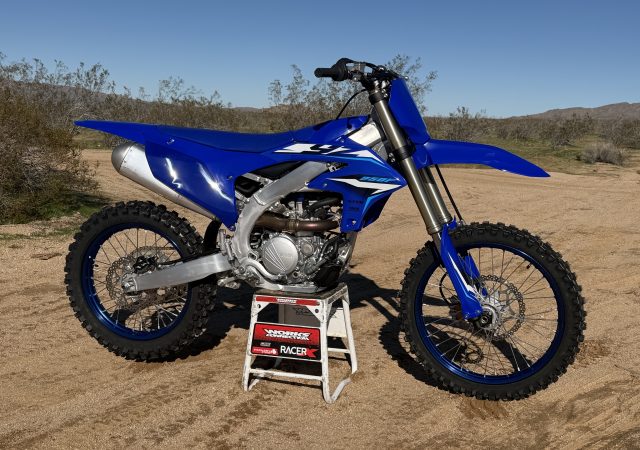
For this edition of Classic Steel, we are going to look back at Yamaha’s all-new YZ80 for 1993.
 Larger, faster, and sleeker than its predecessor, the YZ80 was transformed from an also-ran to a major contender in 1993. Photo Credit: Yamaha
Larger, faster, and sleeker than its predecessor, the YZ80 was transformed from an also-ran to a major contender in 1993. Photo Credit: Yamaha
The mini-class has always been an interesting one. More than any other division, the mini class has to cater to an incredibly wide range of rider skills and sizes. Everyone from 8-year-olds right off of trail bikes to 15-year-olds ready to move up to the 250 four strokes can find themselves on mini machines. This has led to a tremendous variety of choices in the mini division. Some manufacturers cater to the next Eli Tomac with all the latest and greatest in technology, while other brands prefer to keep the costs down by recycling older designs. In the case of Honda, you can even have a four-stroke if you prefer to buck the conventional mini-class two-stroke standard.
 With a platform that could trace its roots back to the mid-1980s, the YZ80 was a decent beginner bike in need of a major revamp in 1992. Photo Credit: Yamaha
With a platform that could trace its roots back to the mid-1980s, the YZ80 was a decent beginner bike in need of a major revamp in 1992. Photo Credit: Yamaha
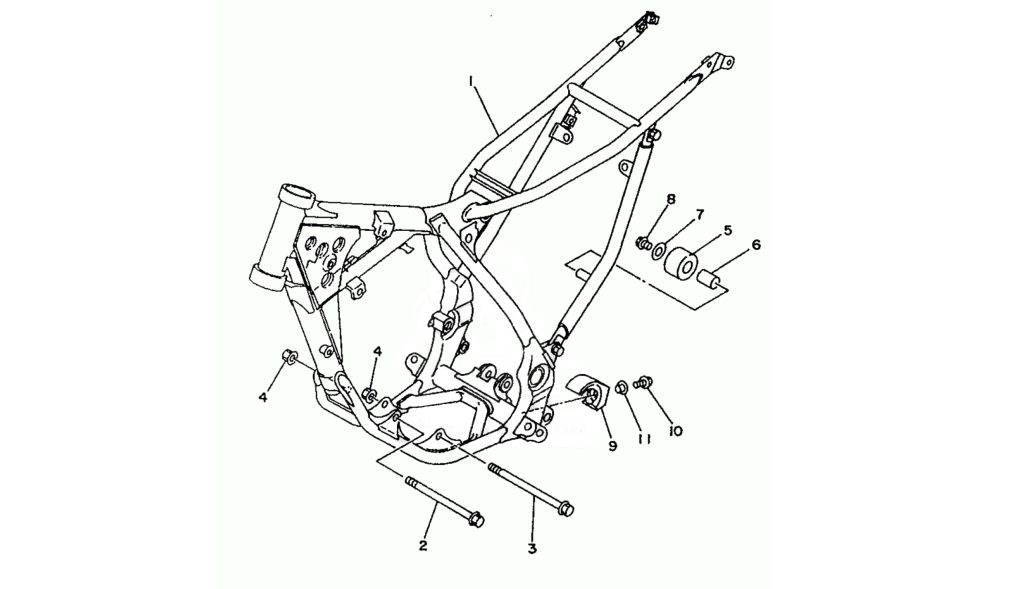 An all-new frame for 1993 added a fully boxed swingarm pivot and beefed-up tubing to produce one of the strongest chassis in the mini class. Photo Credit: Yamaha
An all-new frame for 1993 added a fully boxed swingarm pivot and beefed-up tubing to produce one of the strongest chassis in the mini class. Photo Credit: Yamaha
Just as today, the mini class of 1992 was a mix of old and new designs. Kawasaki’s KX80 was all-new in 1991, but the rest of the 80cc class could trace their roots back to the mid-1980s. In the case of Yamaha’s YZ80, its design had not changed in any significant way since its introduction in 1986. All-new that season, the YZ80 slotted in as a mid-sized machine with solid and easy-to-use power. It was smaller overall than the Suzuki and Honda but on par with the Kawasaki’s dimensions. Novice riders loved its chunky low-end but fast guys preferred the blistering midrange blast of the CR80R.
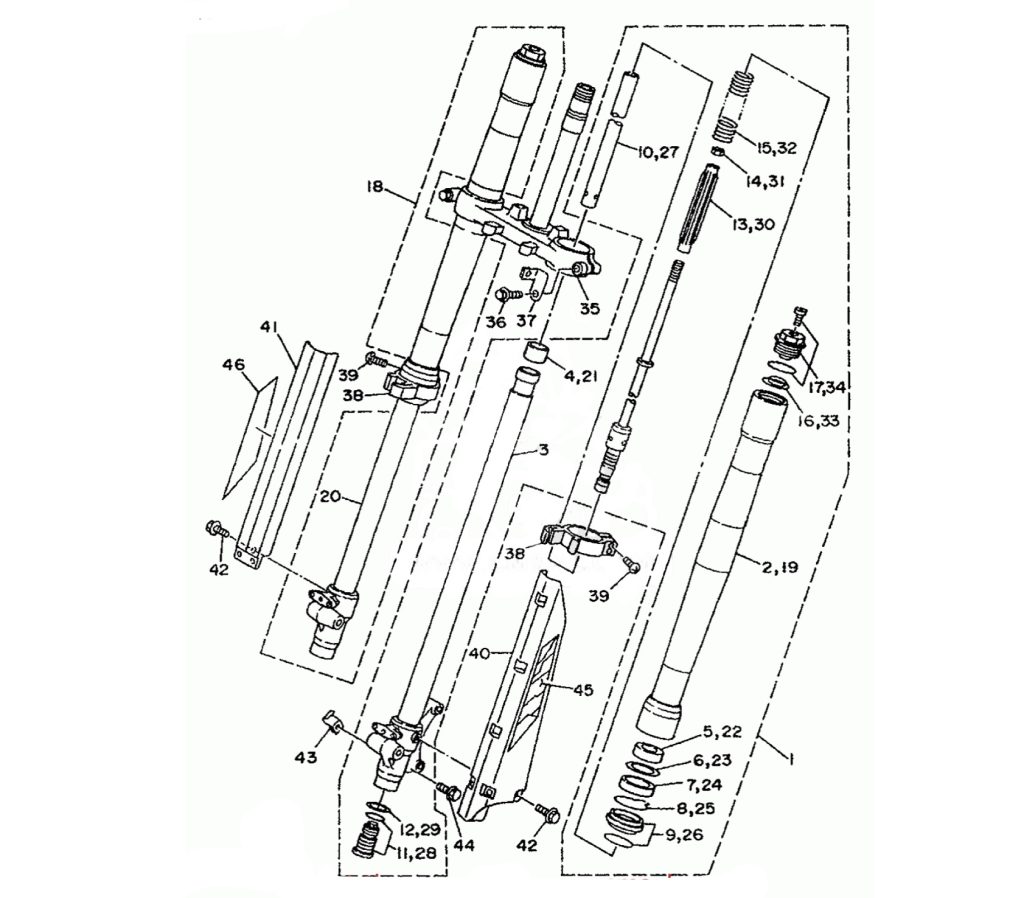 All-new 36mm inverted cartridge fork for 1993 increased chassis stiffness and improved steering precision. Even without any external adjustments, these were the most advanced forks in the class in 1993. Photo Credit: Yamaha
All-new 36mm inverted cartridge fork for 1993 increased chassis stiffness and improved steering precision. Even without any external adjustments, these were the most advanced forks in the class in 1993. Photo Credit: Yamaha
Over the next six years, the mini-class ideal shifted as the chassis grew and horsepower increased. In 1989, Suzuki upended the powerband hierarchy with the introduction of their power-valve equipped RM80. The RM’s all-new AETC (Automatic Exhaust Timing Control) case-reed mill combined powerband flexibility and high horsepower in an unbeatable motor package. Beefier forks, longer travel suspension, and stouter frames all allowed the mini-class pilots of the late eighties and early nineties to push their machines like never before.
 All three Yamahas in the YZ lineup picked up major redesigns for the 1993 season. Photo Credit: Yamaha
All three Yamahas in the YZ lineup picked up major redesigns for the 1993 season. Photo Credit: Yamaha
As the class standard moved forward, Yamaha’s YZ80 remained firmly entrenched in the mid-1980s. By 1992, its mellow motor was no longer competitive, and its once mid-sized dimensions were positively Lilliputian. Its small chassis, short suspension, and low horsepower made it a decent beginner machine, but for anyone with greater skill and aspirations, it was too outdated to be competitive.
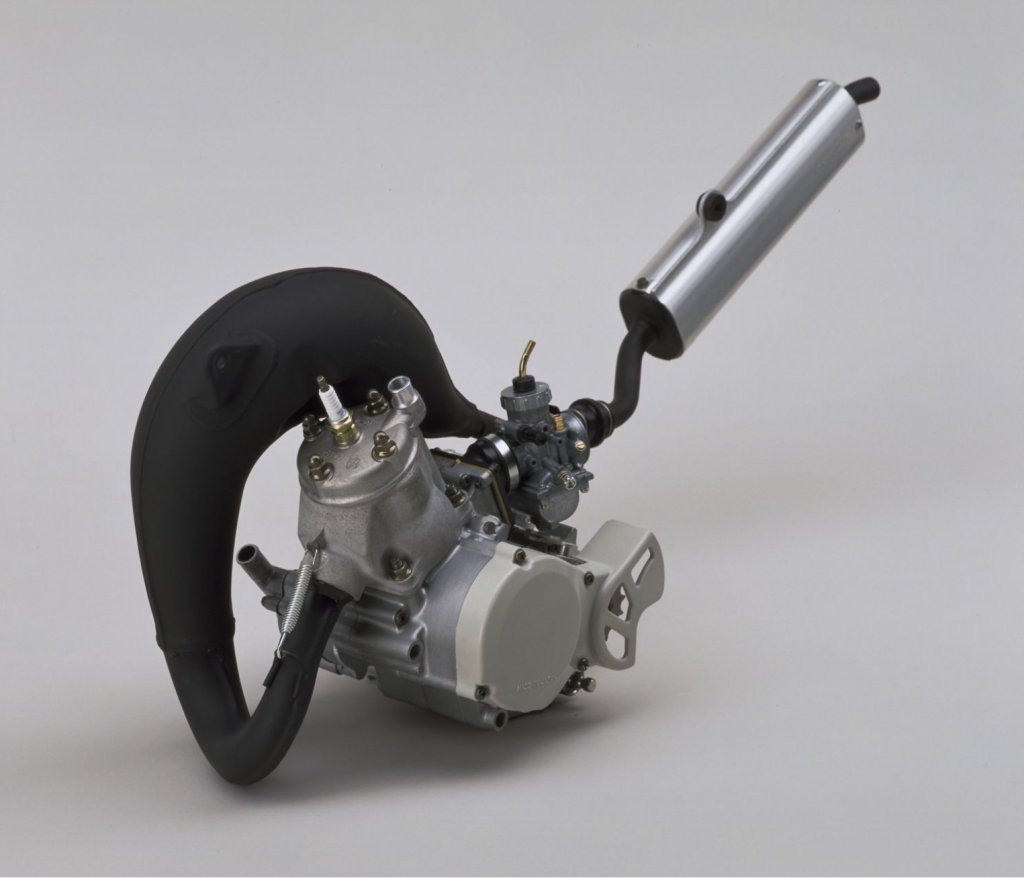 The YZ80’s all-new motor moved to a case-reed design for improved top-end power in 1993. While the engine was thoroughly modern in most respects, its lack of a variable exhaust port proved detrimental to its usability on the track. Photo Credit: Dirt Bike
The YZ80’s all-new motor moved to a case-reed design for improved top-end power in 1993. While the engine was thoroughly modern in most respects, its lack of a variable exhaust port proved detrimental to its usability on the track. Photo Credit: Dirt Bike
Enter 1993, and Yamaha’s first all-new mini in nearly a decade. Redesigned from the ground up, the 1993 Yamaha YZ80 was easily the most radical reimagining of Yamaha’s mini-class platform since liquid cooling was added in 1982. The new chassis was larger overall, with stronger tubing throughout. A new fully removable subframe aided shock maintenance and a larger airbox offered improved breathing. A new “Deltabox” swingarm was longer and stronger and both the seat height and ground clearance were increased to better accommodate a wider range of riders. Larger footpegs improved comfort and control and all-new bodywork offered a slimmer and sleeker profile than in 1992. The new bodywork closely resembled the look of the all-new YZ125 and YZ250 and leapfrogged the YZ from moldy oldy to one of the most handsome machines in the class. New brakes graced the YZ as well and the Yamaha finally joined the ranks of dual-disced machines for 1993.
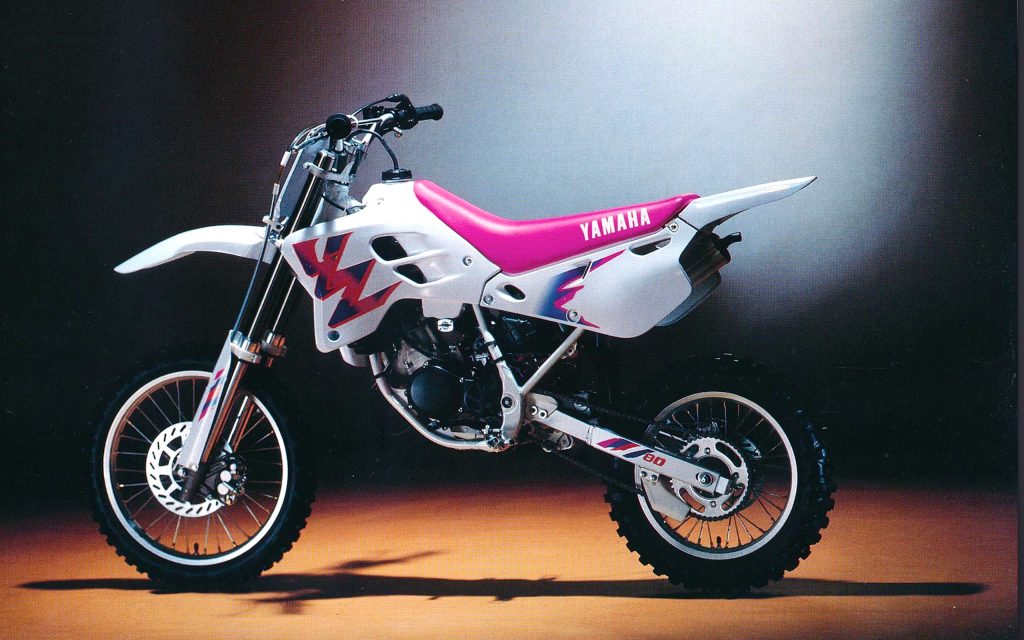 YZ80s in some other markets got the sexy new bodywork but kept the Magenta look of 1991-1992. Photo Credit: Yamaha
YZ80s in some other markets got the sexy new bodywork but kept the Magenta look of 1991-1992. Photo Credit: Yamaha
On the suspension front, the redesigned YZ was just as radically upgraded for 1993. All-new 36mm forks moved from a conventional to an inverted design and offered almost a full inch more travel than in 1992. Internally, a new cartridge system improved damping but the forks continued to lack the external adjustability of their larger siblings. In 1993, none of the other machines in the 80cc division offered the performance advantage of a cartridge damping system aside from Kawasaki’s class-busting KX80 Big Wheel. In the rear, a redesigned Monocross linkage and Kayaba shock also offered an inch more travel and full adjustments for compression and rebound damping.
 A sano alloy silencer and trick airbox intake integrated into the rear fender highlighted the rear of the all-new YZ80. Photo Credit: Motocross Action
A sano alloy silencer and trick airbox intake integrated into the rear fender highlighted the rear of the all-new YZ80. Photo Credit: Motocross Action
With the motor design, Yamaha chose to go with an interesting mix of old and new technology for 1993. The redesigned 82.9cc mill moved to a case-reed design for ’93 but continued to lack any sort of a variable exhaust valve to broaden power. This certainly kept costs down, but it meant that it would be more difficult for Yamaha’s engineers to develop the sort of broad powerband that made the RM80’s mill such a hit. While the cylinder lacked a power valve, it did offer a tough ceramic composite liner that enhanced heat dispensation and durability. Improved reliability came through the use of a larger wrist pin and beefed-up main bearings for the crank and a redesigned piston. Mixing duties continued to be handled by Mikuni’s proven 26mm round-slide VM26SS carburetor, but an all-new reed valve and airboot promised improved flow characteristics for increased power. On the exhaust side, an all-new “low-boy” expansion chamber lowered the center of gravity and improved ergonomics while a sano alloy silencer improved looks and took some of the bite out of the previous YZ’s raspy exhaust note.
In the bottom end, the redesigned YZ’s mill offered an all-new transmission and beefed-up clutch for increased durability. The ratios for the first through third gears were lowered, while the fourth, fifth, and sixth gears were raised slightly. This was done to help the YZ feel snappier out of turns while still maintaining solid top-end performance.
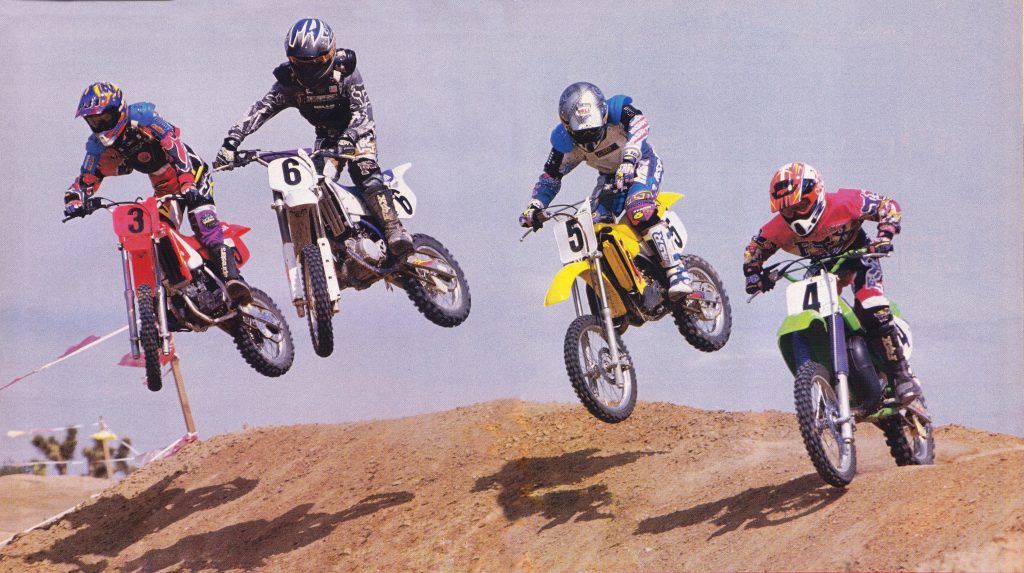 In 1993, the mini class was a fascinating mix of old and new technology. The RM80 offered the only power valve in the class with the KX and YZ featuring beefy forks and stout modern chassis. Interestingly, the Honda’s eight-year-old motor still had the juice to run with its newer rivals, but its mid-eighties chassis and suspension held it back from being a serious contender. Photo Credit: Dirt Bike
In 1993, the mini class was a fascinating mix of old and new technology. The RM80 offered the only power valve in the class with the KX and YZ featuring beefy forks and stout modern chassis. Interestingly, the Honda’s eight-year-old motor still had the juice to run with its newer rivals, but its mid-eighties chassis and suspension held it back from being a serious contender. Photo Credit: Dirt Bike
On the track, the YZ80 was completely transformed for 1993. The new chassis was incredibly stout and the Why-Zed could be charged into obstacles that would have had the old machine bottoming and floundering. The revamped ergonomics made the bike much easier to move around on and the machine no longer felt like a toy to those over 5’3”. The strong frame, flex-free forks, and excellent geometry allowed the YZ to stick like glue in the turns and remain rock-solid at speed. It was a great do-it-all chassis that allowed skilled riders to push the machine to its limits without fear of it getting out of shape or doing anything unexpected.
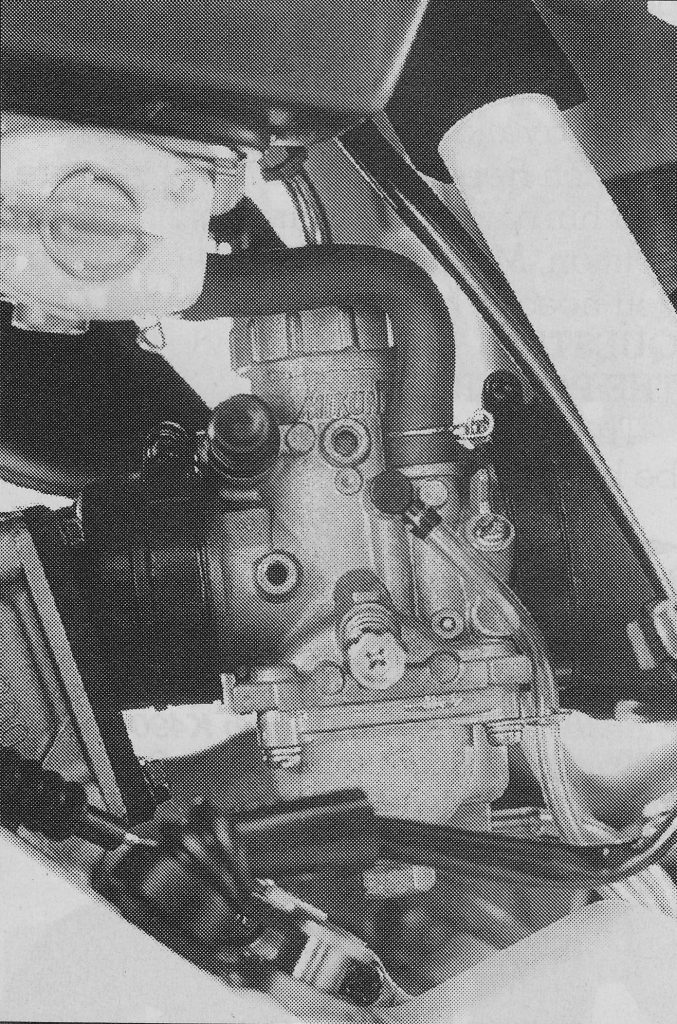 While the motor was all-new, Yamaha decided to recycle the old engine’s 26mm round-slide Mikuni for 1993. Photo Credit: Motocross Action
While the motor was all-new, Yamaha decided to recycle the old engine’s 26mm round-slide Mikuni for 1993. Photo Credit: Motocross Action
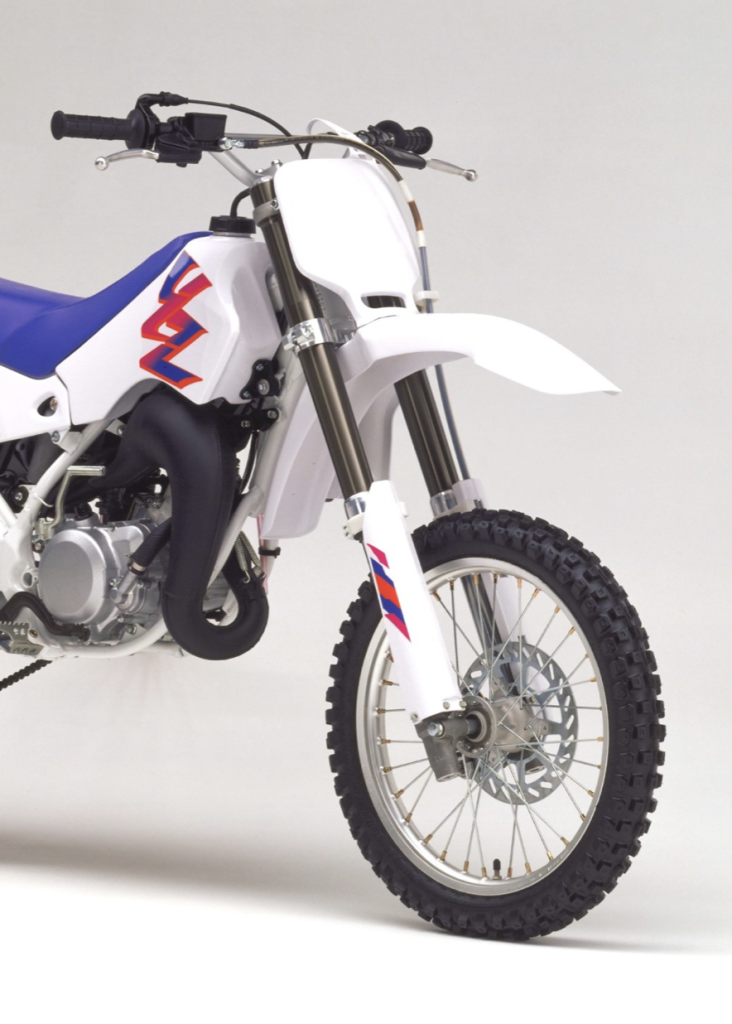 The YZ80’s all-new 36mm inverted forks proved a significant upgrade over the old model’s undersized conventional units. Riders of all skill levels appreciated their flex-free performance, but heavier and faster pilots did feel their action would have benefited from stiffer springs. Photo Credit: Yamaha
The YZ80’s all-new 36mm inverted forks proved a significant upgrade over the old model’s undersized conventional units. Riders of all skill levels appreciated their flex-free performance, but heavier and faster pilots did feel their action would have benefited from stiffer springs. Photo Credit: Yamaha
Like the chassis, the suspension on the YZ was on a whole different level in 1993. The brawny inverted cartridge forks allowed fast kids to charge into the steep jump faces and slam into whoops like a pint-sized Damon Bradshaw and the well-sorted KYB shock gobbled up terrain like Cookie Monster on a chocolate chip bender. Really big jumps could bottom the forks, but they reacted well when pushed and did a good job of keeping the “clank” out of any major sky shots. Without any means of external adjustment, it was up to oil level, spring rate, and viscosity if you wanted to fine-tune their action. Thankfully, they worked well for most serious mini-pilots in stock form. Heavy or fast riders would have benefited from stiffer springs up front, but the overall suspension package was rated the best in the 1993 mini class.
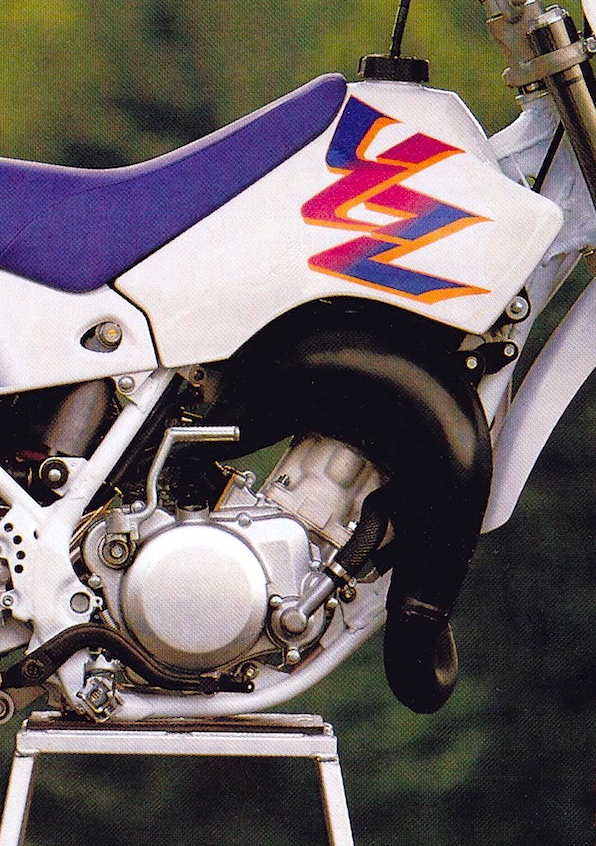 The YZ80’s all-new motor was substantially more powerful but significantly harder to ride than its outgoing design. There was not a lot of torque off idle, but the mill produced a strong midrange and top-end pull. As long as you had the skill to keep it on the pipe the YZ was capable of running with any other machine in the class. Photo Credit: Yamaha
The YZ80’s all-new motor was substantially more powerful but significantly harder to ride than its outgoing design. There was not a lot of torque off idle, but the mill produced a strong midrange and top-end pull. As long as you had the skill to keep it on the pipe the YZ was capable of running with any other machine in the class. Photo Credit: Yamaha
On the motor front, the YZ’s fortunes became murkier. The new motor pumped out tons of power, but it did so in a fashion that was far harder to use than its more novice-friendly predecessor. The new case-reed engine was sluggish down low, with very little torque available below the midrange. Once on the pipe, the YZ pulled strongly with a solid midrange burst and a decent top-end hook. Once it was into the meat of its power, the YZ was as fast as anything in the class, but that burst was rather short-lived. The new powerband pulled much farther than the previous YZ80s, but it still signed off before true rev-rockets like the CR80R. To make the most of the YZ’s mid-and-up burst motor, you had to keep it right on the bubble and time your shifts perfectly. Unfortunately, however, this was far from an easy task. The new transmission proved just as notchy as previous Yamaha efforts and the YZ continued to offer the worst shifting performance in the class. Power shifting the little YZ was virtually impossible, and the white and purple mini demanded you feed in some clutch and back off the throttle slightly to properly engage the next cog under power. This made its already difficult powerband even trickier to use.
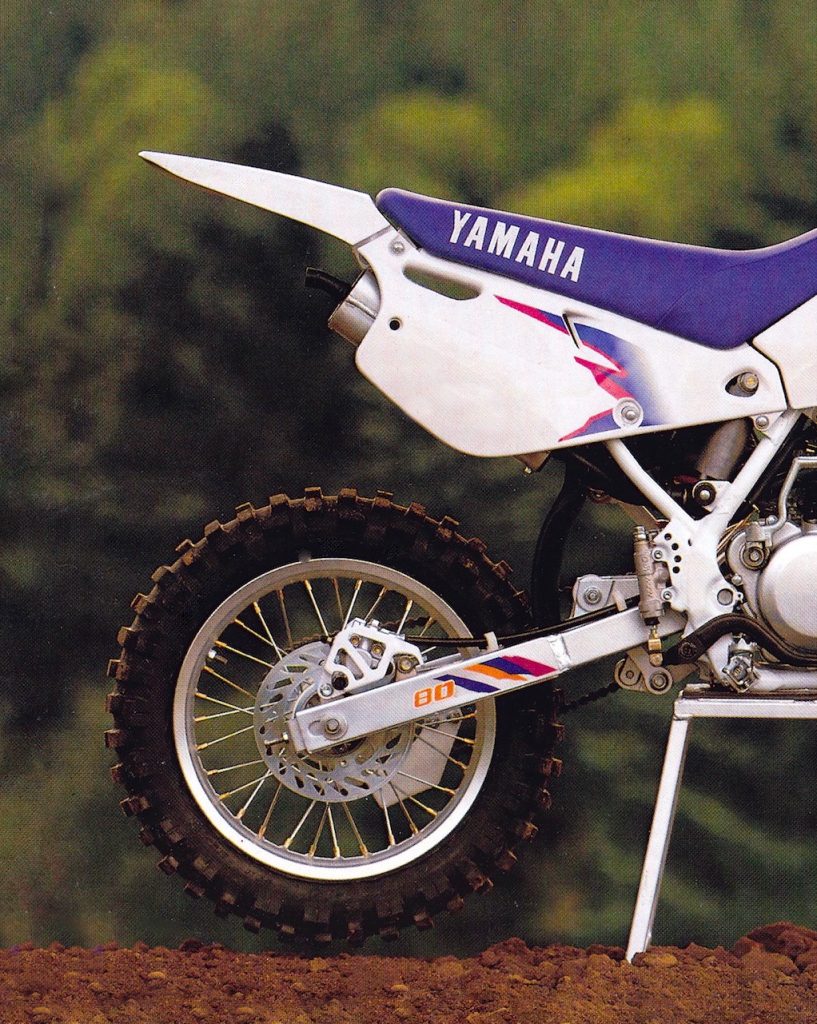 The all-new Monocross rear suspension on the YZ delivered a well-controlled ride that was tops in the class. While the shock was capable of handling anything a pint-sized pro could dish out, the rear wheel was not up to the same challenge. Photo Credit: Yamaha
The all-new Monocross rear suspension on the YZ delivered a well-controlled ride that was tops in the class. While the shock was capable of handling anything a pint-sized pro could dish out, the rear wheel was not up to the same challenge. Photo Credit: Yamaha
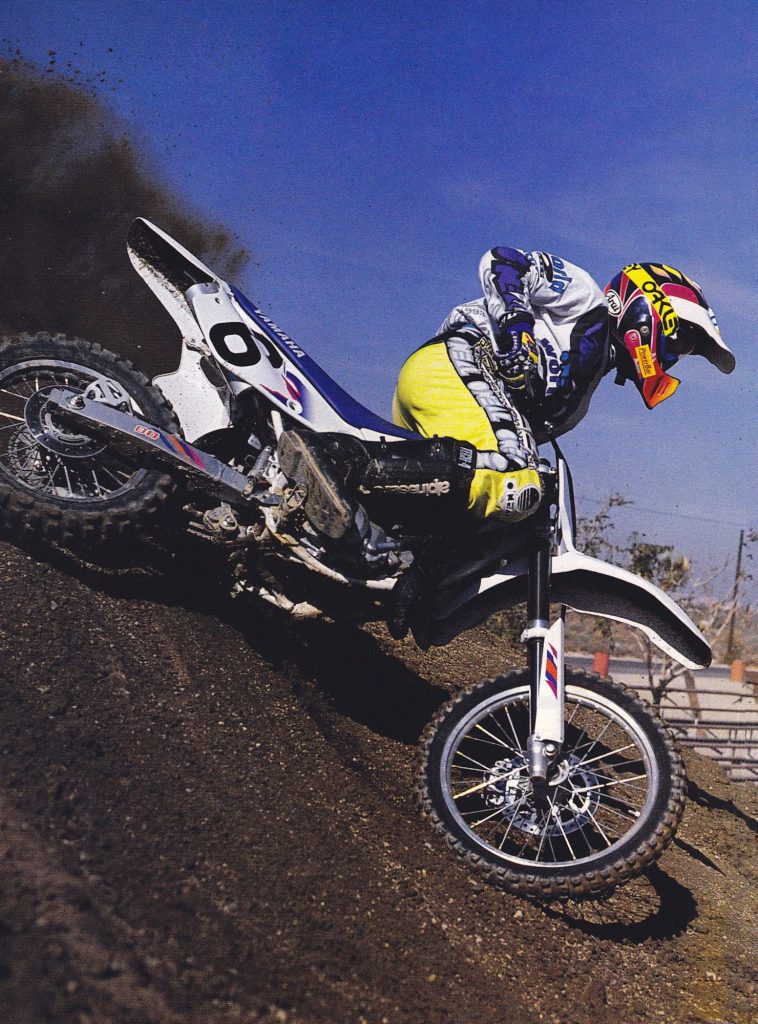 The YZ’s excellent handling was its biggest advantage in 1993. Photo Credit: Yamaha
The YZ’s excellent handling was its biggest advantage in 1993. Photo Credit: Yamaha
For experts, the stubborn shifting was an annoyance, but most of them could make the YZ’s mid-and-up powerband work. For slower riders, however, the YZ’s peaky motor and cranky transmission could be a real hindrance. The Yamaha was certainly faster than in the past and it was more potent than Kawasaki’s KX80. It pulled farther on top than the RM but was much harder to ride. The Honda still had everyone else covered on top despite its eight-year-old design. It was blisteringly fast a high RPM, but like the Yamaha, it lacked the low-end grunt of the power-valved RM. Overall, it was a much more competitive power package if you had the talent to keep its tiny motor percolating.
On the detailing front, the YZ was excellent with only a few caveats in 1993. The graphics looked great, the ergonomics were excellent (particularly for larger kids), the brakes were powerful, and the motor was bulletproof. The powerband was pipey and the transmission was notchy, but the motor held together well with regular maintenance. The sturdy frame and beefed-up suspension gave the YZ a far more substantial feel than most of its rivals and this let fast kids push the machine’s limits. Unfortunately, however, this also exposed one of the new machine’s major weaknesses.
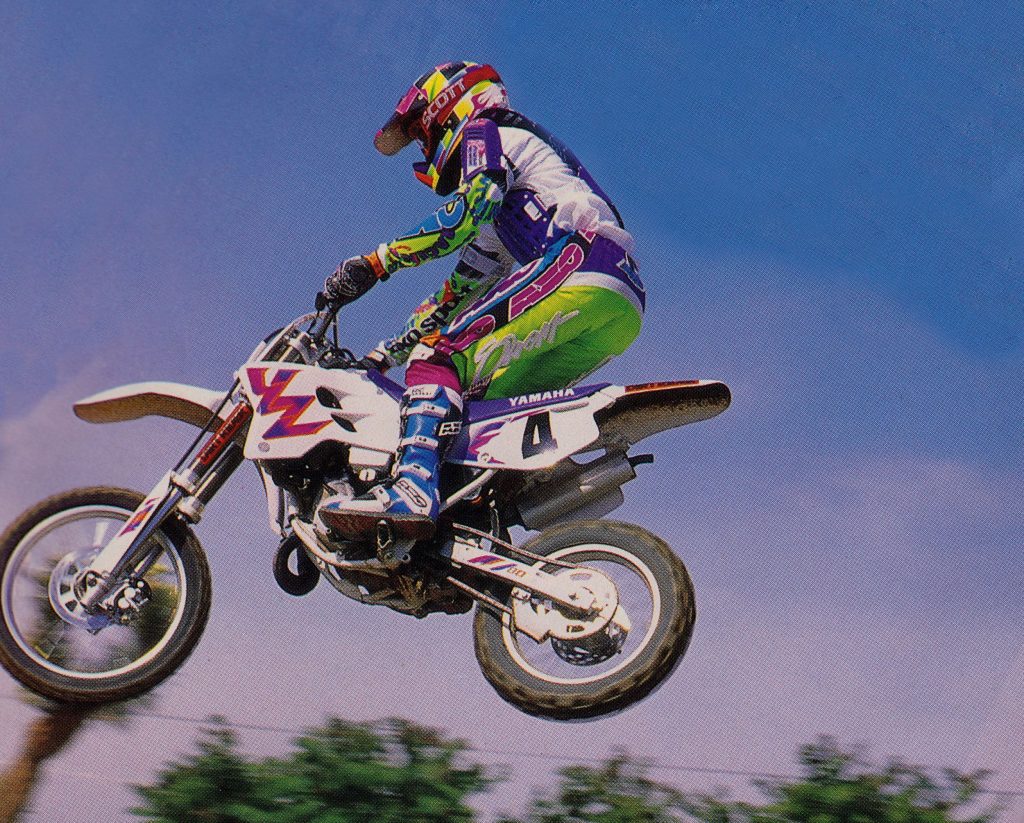 Slim ergonomics and excellent aerial manners let fast kids do their best Damon Bradshaw impression in 1993. Photo Credit: Dirt Rider
Slim ergonomics and excellent aerial manners let fast kids do their best Damon Bradshaw impression in 1993. Photo Credit: Dirt Rider
As tough as the new chassis proved to be, its wheels demonstrated to be just as fragile. Hard chargers and Jeff Emig wannabees quickly found that the YZ’s rear wheel was not up to withstanding the pounding the rest of the bike could deliver. Exploding rear wheels became a common issue for fast mini kids with the skill and cajones to air out the new YZ. The bike’s carburation was also suspect at times with the motor suffering from an annoying and potentially dangerous bog when landing from large jumps. While most YZ80s were not likely to find themselves on a Supercross track, this irritating carburation glitch could still lead to unpleasant consequences if not addressed. Aside from these two issues, however, the YZ was amazingly well-sorted for an all-new design.
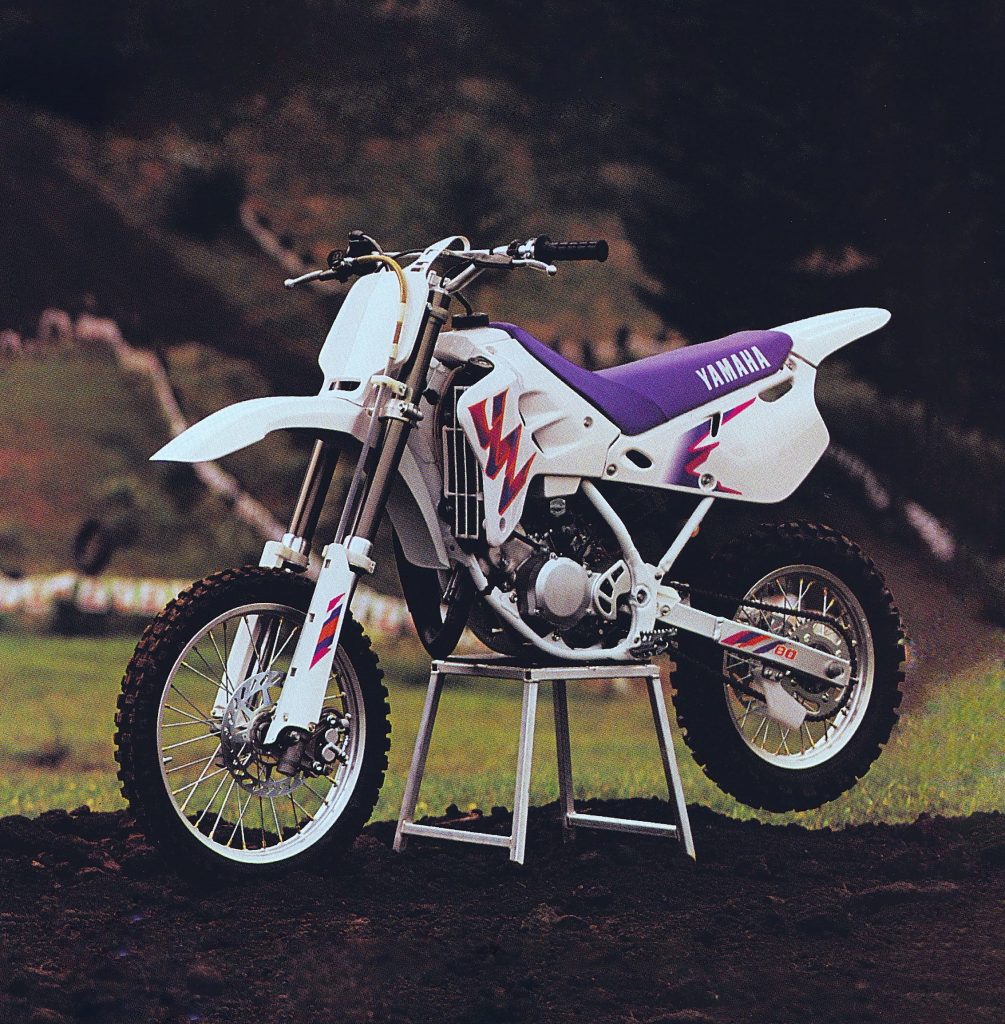 Yamaha’s all-new YZ80 offered suspension and handling to rule the class, but its mid-and-up powerband and notchy shifting made it a demanding dance partner in 1993. Photo Credit: Yamaha
Yamaha’s all-new YZ80 offered suspension and handling to rule the class, but its mid-and-up powerband and notchy shifting made it a demanding dance partner in 1993. Photo Credit: Yamaha
Overall, the 1993 YZ80 turned out to be a huge step forward for Yamaha’s mini-class aspirations. After six years of being the class whipping boy, Yamaha came out swinging in 1993 with a machine that leapfrogged the YZ to the front of the pack. Larger, faster, and more expert oriented, the new YZ offered kids with the size and talent to make use of its potential the perfect platform for motocross stardom. With its narrow powerband and large size, the YZ was no longer a good fit for beginners, but if you had the drive to be the next Beast from the East, it had the right stuff to make that a reality.
For your daily dose of classic moto, you can follow me @tonyblazier on Twitter and Instagram.


